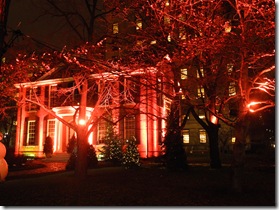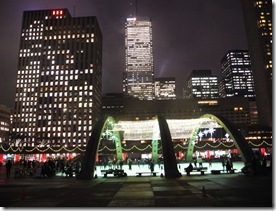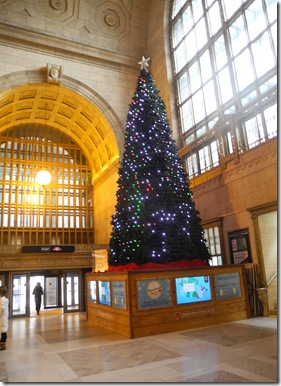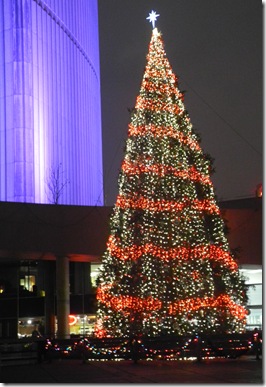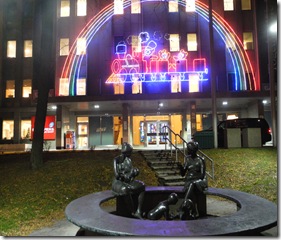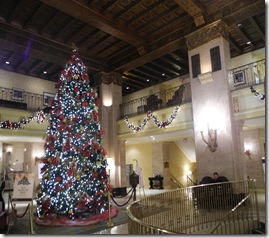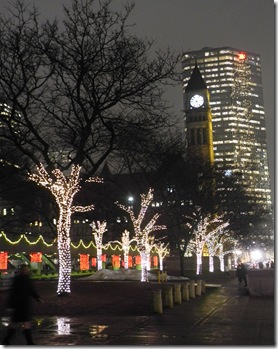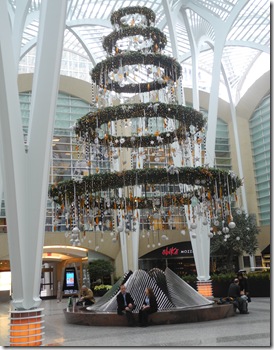Most people retain fond memories of Christmas’ past. However, being born in Toronto, I have come to realize that I am lucky to remain in the same city in which I grew up. Toronto is now a multi-cultural urban centre that attracts people from all over the world, as well as from other parts of Canada. Thus, not everyone shares memories of the city that extend over several decades.
My boyhood years were during the 1940s. I realize that most people now consider these years to be the dark ages – prior to TV’s and computers. The Eaton’s Santa Claus Parade, held on a Saturday morning in November, kicked off the Christmas season. At the end of the parade, Santa entered the Eaton’s store on a tall ladder extended from a fire truck. From that moment forward, all children’s thought led to Santa Claus’s throne in Eaton’s Toyland, on the fifth floor of the store at Queen and Yonge Streets. Because shoppers patronized either Eaton’s or Simpson’s, not usually both, whichever store the family usually shopped at was considered to possess the “real” Santa Claus. The one at the other store merely a helper. For us, the “real” one was at Eaton’s. However, the Simpson’s windows on the south side of the Queen Street store were always a highlight of the season. Today, The Bay retains the tradition. In the 1940s, after “Santa came to town,” the Santa broadcasts, naturally sponsored by Eaton’s, began on the radio.
When I was a child, at least once during the Xmas season, a Salvation Army band arrived on our street to play carols. As the bandsmen gathered under the streetlight to play their brass instruments, volunteers went to the houses to collect contributions. It was also an era when children went door to door in the chill of the winter evenings to sing carols to earn a few coins. My brother and I did well in this endeavour, as we were able to sing in two-part harmony. The money we earned bought hankies and socks for our parents and grandparents, the gifts purchased in either Woolworth’s (later renamed Woolco) or Kresgees (K-Mart).
In the 1940s, Xmas trees were sold in vacant lots in residential neighbourhoods, the vendor huddled around an iron barrel where a crackling fire sent sparks dancing high in the frosty air. Today, it is rare to find any vacant lots in our densely populated residential areas. There were no plazas or box-store outlets where yuletide trees were sold. As a child, I thought that the Xmas tree lots were like vast forests, with numerous paths between the many rows of pine and spruce. The chosen tree was hauled home on a sleigh. Our tree was always a spruce. There were no artificial trees.
After New Year’s day, the abandoned trees lined the streets beside the garbage cans. Bits of tinsel hung forlornly from their thinning branches. Sometimes, my brother and I gathered up as many trees as we were able and stacked them alongside the garage so that we could leap from the garage roof into the pile of trees. Our parents were not amused by the antics. In early spring, my dad hauled the trees back to their curb-side positions beside the garbage cans.
Because of these memories, today I take great delight in participating in the activities leading to Christmas. One of these activities is to visit the numerous places in the city where yuletide trees decorate the avenues, squares, or office buildings. I have already placed posts on this site about the Santa Claus Parade, the Santa radio broadcasts, and the Simpson’s (The Bay) windows. Now I would like to share photos of a few of the places where trees and decorations will make this anther year to remember.
Merry Christmas to all.
Campbell House, Queen and University City Hall skating rink
Union Station City Hall
Sick Kid’s Hospital Lobby, Royal York Hotel
Queen Street West beside City Hall Inside Brookfield Place
For a link to the Home Page, other posts about Christmas in Toronto, and books about Toronto: https://tayloronhistory.com/
